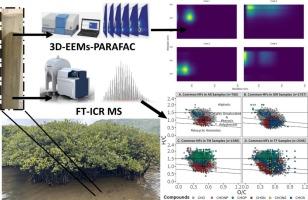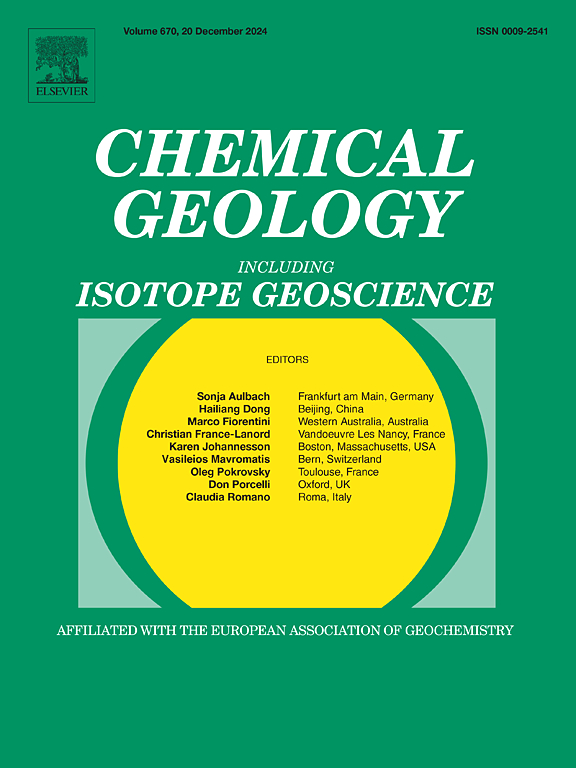红树林沉积溶解有机物的分子指纹:对蓝碳封存的重要性
IF 3.6
2区 地球科学
Q1 GEOCHEMISTRY & GEOPHYSICS
引用次数: 0
摘要
红树林是重要的有机碳(OC)库,可以减缓气候变化。虽然沉积溶解有机物(SDOM)已被确定为这些生态系统中的主要有机碳成分,但其分子组成、来源和归宿在很大程度上仍不为人所知。本研究采用吸收荧光光谱法和超高分辨率质谱法等技术,研究了中国最大的城郊红树林之一及其附近滩涂中的 SDOM 分子。我们发现,红树林中的 SDOM 与非红树林生态系统中的 SDOM 有很大不同。红树林的存在使含 N 和 S 的 SDOM 分子含量随深度增加而增加,并表现出更高的易变性。不过,亚缺氧的红树林沉积物可能限制了微生物的活动,从而促进了易变 SDOM 的保存。红树林垃圾还有助于在沉积物中形成富含羧基的脂环族分子,有可能转化为具有生物难溶性的 SDOM,成为 OC 吸收汇。由于对红树林中 SDOM 分子指纹的了解仍处于早期阶段,这些发现提供了分子水平的证据,证明红树林沉积物通过保存和转化过程促进了 OC 固碳。这项研究为了解 SDOM 在碳封存中的作用提供了重要启示,该方法可应用于其他蓝碳生态系统。本文章由计算机程序翻译,如有差异,请以英文原文为准。

Molecular fingerprints of sedimentary dissolved organic matter in mangroves: Importance to blue carbon sequestration
Mangroves are important organic carbon (OC) reservoirs that can mitigate climate changes. Although sedimentary dissolved organic matter (SDOM) has been established as a dominant OC component within these ecosystems, its molecular composition, origin, and fate remain largely unknown. This study examined SDOM molecules from one of the largest peri-urban mangroves and adjacent tidal flats in China by using techniques like absorption fluorescence spectroscopy and ultrahigh-resolution mass spectrometry. We found that SDOM in mangroves differs significantly from that in non-mangrove ecosystems. The presence of mangroves created higher levels of N- and S-containing SDOM molecules with depth and exhibited higher lability. However, the suboxic mangrove sediments may limit microbial activity, promoting labile SDOM preservation. Mangrove litter also contributed to the formation of carboxyl-rich alicyclic molecules in sediments, potentially transforming into biologically refractory SDOM that acts as OC sinks. As the understanding of molecular fingerprints of SDOM in mangroves is still at early stages, these findings provide molecular-level evidence that mangrove sediments promote the OC sequestration through preservation and transformation processes. This study offers crucial insights into the role of SDOM in carbon sequestration and the method could be applied into other blue carbon ecosystems.
求助全文
通过发布文献求助,成功后即可免费获取论文全文。
去求助
来源期刊

Chemical Geology
地学-地球化学与地球物理
CiteScore
7.20
自引率
10.30%
发文量
374
审稿时长
3.6 months
期刊介绍:
Chemical Geology is an international journal that publishes original research papers on isotopic and elemental geochemistry, geochronology and cosmochemistry.
The Journal focuses on chemical processes in igneous, metamorphic, and sedimentary petrology, low- and high-temperature aqueous solutions, biogeochemistry, the environment and cosmochemistry.
Papers that are field, experimentally, or computationally based are appropriate if they are of broad international interest. The Journal generally does not publish papers that are primarily of regional or local interest, or which are primarily focused on remediation and applied geochemistry.
The Journal also welcomes innovative papers dealing with significant analytical advances that are of wide interest in the community and extend significantly beyond the scope of what would be included in the methods section of a standard research paper.
 求助内容:
求助内容: 应助结果提醒方式:
应助结果提醒方式:


